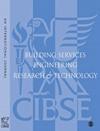Assessing the performance gap of two dynamic thermal modelling software tools when comparing with real-time data in relation to thermal loss
IF 1.8
4区 工程技术
Q3 CONSTRUCTION & BUILDING TECHNOLOGY
Building Services Engineering Research & Technology
Pub Date : 2023-02-03
DOI:10.1177/01436244231153839
引用次数: 0
Abstract
Managing thermal loss is a key topic that needs further investigation as it has a direct link to reducing the energy load in buildings. One of these thermal loss management methods can be the use of shading devices. Dynamic thermal models normally used at the early stages of the building design can play an important role in the decision-making process regarding the use of shading devices. This paper presents the results of a real-world study assessing the potential of using a sealed cellular blind as a passive energy conservation method, where the real-world results are compared with the simulated results generated with environmental design solutions limited thermal analysis software (EDSL Tas) and integrated environmental solutions virtual environment (IES VE). During the real-world study, a positive impact of having blinds was seen whereby the window surface temperature increased and office heating energy consumption was lowered. Both software tools were able to predict a similar trend of results for the window surface temperature in with and without blind scenarios whereas for energy consumption although in the presence of a blind a consistent correlation is seen between measured and calculated values but not without a blind. This can be attributed to the inability of the software tools in demonstrating the effect of infiltration in the absence of a blind or shading device i.e., a clear window scenario. Practical Application The performance gap analysis regarding thermal loss between dynamic thermal models and real-world settings within buildings can enhance the predictability of the building energy software tools used by designers. Early design inputs within buildings can prevent costly building re-work to improve the building’s energy performance. This can also improve the understanding within the building industry of the importance of reducing thermal loss through the use of shading devices and ensuring the software tools used to model these devices are as close to real-world settings as possible.在与热损失相关的实时数据进行比较时,评估两种动态热建模软件工具的性能差距
管理热损失是一个需要进一步研究的关键话题,因为它与降低建筑物的能源负荷有直接联系。这些热损失管理方法之一可以是使用遮光设备。通常在建筑设计的早期阶段使用的动态热模型可以在有关遮阳设备使用的决策过程中发挥重要作用。本文介绍了一项真实世界的研究结果,该研究评估了使用密封蜂窝百叶窗作为被动节能方法的潜力,其中将真实世界的结果与环境设计解决方案有限热分析软件(EDSL Tas)和集成环境解决方案虚拟环境(IES VE)生成的模拟结果进行了比较。在现实世界的研究中,百叶窗产生了积极的影响,窗户表面温度升高,办公室供暖能耗降低。两种软件工具都能够预测在有盲和无盲情况下窗户表面温度的类似结果趋势,而对于能耗,尽管存在盲,但在测量值和计算值之间可以看到一致的相关性,但并非没有盲。这可能是由于软件工具无法在没有百叶窗或遮光设备的情况下(即,透明窗口场景)证明渗透的效果。实际应用关于建筑物内动态热模型和真实世界设置之间的热损失的性能差距分析可以提高设计师使用的建筑能源软件工具的可预测性。建筑物内的早期设计输入可以防止昂贵的建筑物返工,以提高建筑物的能源性能。这也可以提高建筑行业对通过使用遮阳设备减少热损失的重要性的理解,并确保用于建模这些设备的软件工具尽可能接近真实世界的设置。
本文章由计算机程序翻译,如有差异,请以英文原文为准。
求助全文
约1分钟内获得全文
求助全文
来源期刊

Building Services Engineering Research & Technology
工程技术-结构与建筑技术
CiteScore
4.30
自引率
5.90%
发文量
38
审稿时长
>12 weeks
期刊介绍:
Building Services Engineering Research & Technology is one of the foremost, international peer reviewed journals that publishes the highest quality original research relevant to today’s Built Environment. Published in conjunction with CIBSE, this impressive journal reports on the latest research providing you with an invaluable guide to recent developments in the field.
 求助内容:
求助内容: 应助结果提醒方式:
应助结果提醒方式:


